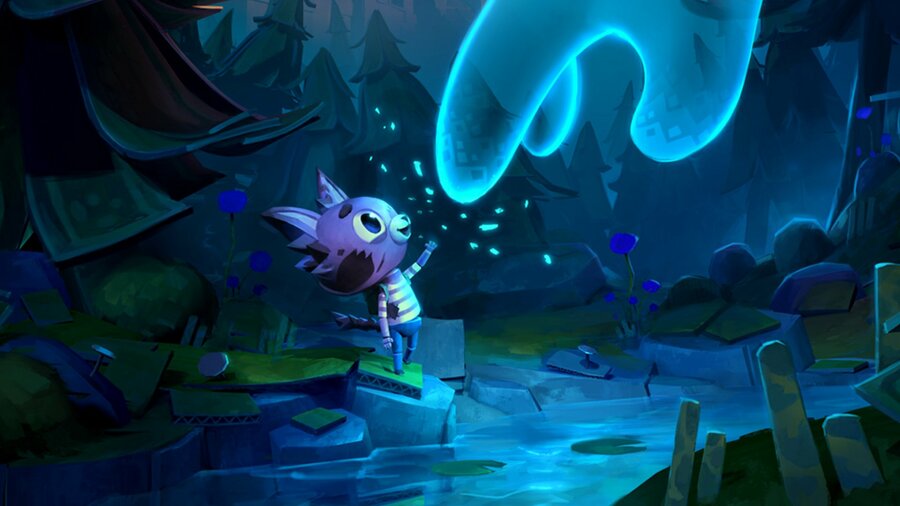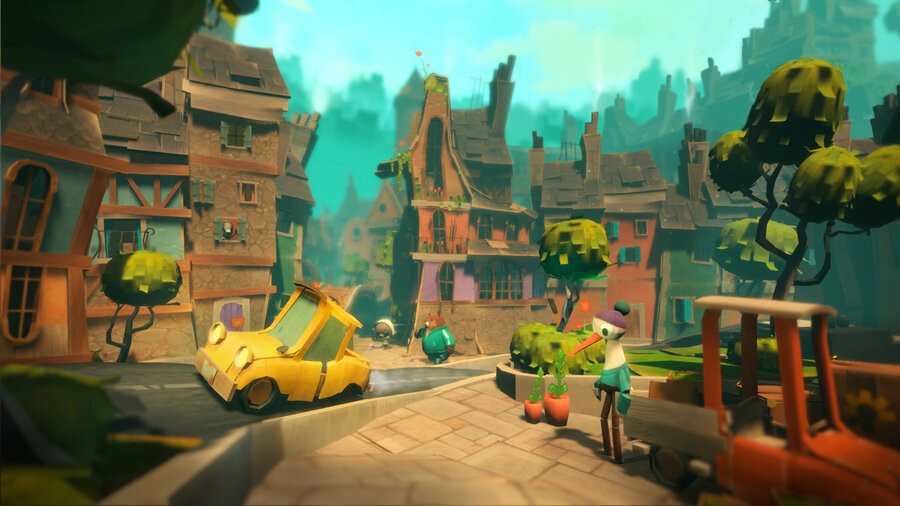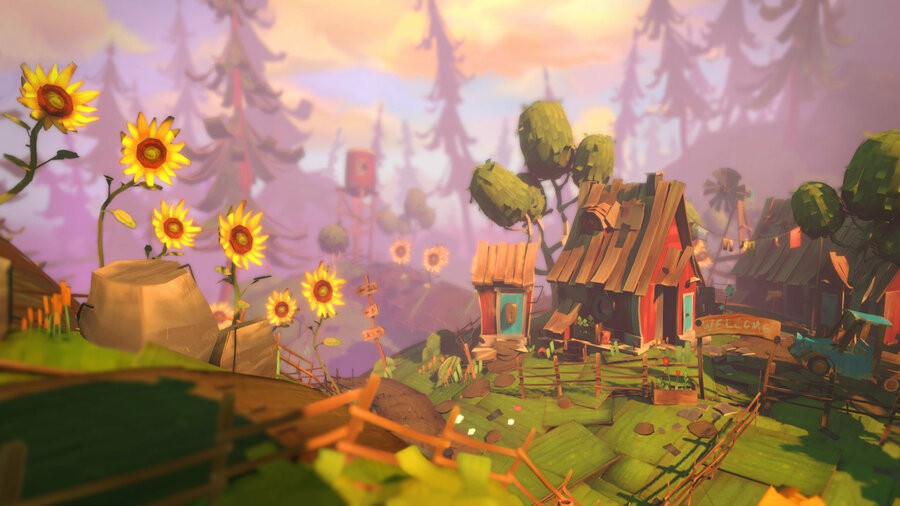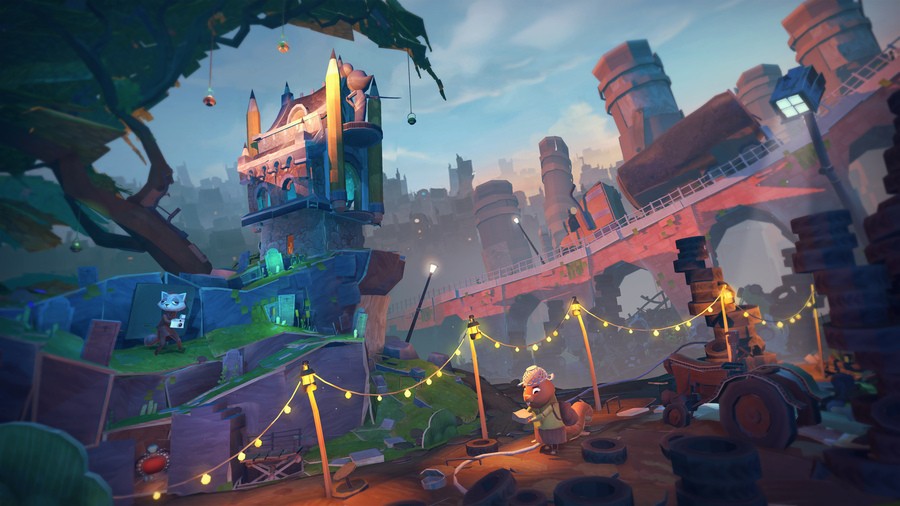
Ghost Giant swept us off our feet when it released just a couple of weeks ago, and we've been thinking about the unique experience it offers ever since we awarded it a 9/10 in the Push Square review. To celebrate the game's critical reception and successful launch, we caught up with developer Zoink! Games to learn of the game's inspiration, how the team tackled the transition from traditional PS4 development to PlayStation VR, and what the studio has planned next.
Push Square: To kick things off, please introduce yourself/yourselves along with your position at Zoink! Games.
Olov Redmalm: Hi! I’m Olov Redmalm, creative director and art director of Ghost Giant. I’m also the
voice of the jogging bear.
Sebastian Strand: And I’m Sebastian Strand, producer and lead programmer of Ghost Giant. I’m
the voice of the project schedule screaming that we can’t add any more features.
As the studio's first virtual reality title, was there a large learning curve to overcome when compared to the development cycle of a more traditional PS4 game?
Olov: There was a bit of an uphill start where we were getting used to the headset, seeing how different the art feels in VR. There was a lot of experimenting and trying to find new ways to tell a story, how to direct the player’s focus without stealing the camera away (because of course in VR that would be horrible for the player). We ended up dimming down the lights and reducing the volume of background noise, pointing a spotlight at important story beats. But once we had those things going for us it was pretty much like developing for the traditional PS4.
Sebastian: There was a lot of technical unknowns on the project from the start. We didn’t know how much we would need to solve ourselves and how much Virtual Reality Toolkit - the VR library we used - would take care of. Luckily VRTK came with a lot of features out of the box, and we were able to stick with it throughout development with just a couple of code changes. We were of course also worried about performance, since maintaining a steady frame rate is not just crucial, but mandatory in VR if you don’t want to induce simulation sickness. But besides that the actual game systems and such did not vary a lot from our previous titles, so we could reuse a substantial amount of code from previous projects such as Flipping Death.

Did you run into any particular challenges while developing for PlayStation VR? How did Sony help out, if so?
Sebastian: Maintaining a steady frame rate on both a PS4 Pro and a base PS4 while rendering a lot of geometry and simulating of complex physical contraptions (such as the houses and the fishing rod crane) was definitely a challenge, but actually not as big as we feared. We had performance in mind from the get-go and only had certain portions of the game where we really needed to go back and optimize. One issue was the tracking while designing the scenes. We specifically tried to design the scenes to only utilize a 180-degrees cone from the player, so that the camera could always see your move controllers (i.e. your hands). It turned out to be too restrictive when trying to cram in all the puzzles, props and collectables we wanted, so we gradually had to move away from it.
Our producer at Sony, Matt, pushed for including snap-turning into the game, not only to allow for more action space but also to help people with non-optimal setups. In the end it was definitely the right choice. I do want to give the guys at Sony a general shoutout for being great to work with. Matt and Julio always believed in us and supported us even though some of our earliest milestones were a bit shaky, Kenneth helped answer all my dumb TRC-related questions and the VR Consultation team gave great feedback and really helped us push all the VR-aspects of the game further.
Olov: Yeah, the guys at Sony have been really amazing to us! Really trusted our vision and let us do our thing, with great feedback and guidance.
Where did the inspiration behind Ghost Giant come from?
Olov: It was Klaus Lyngeled who first came to us and told us about an idea he had, where you’re a giant ghost who’s helping out a boy in trouble, in VR. From the start we were talking about how we, as kids, would build our own little cardboard towns and immerse ourselves in them, wishing the toys who lived there would come alive and create stories on their own. We wanted to channel that feeling of being a kid again, guiding your little friends through a crafted world, finding comfort there when life was tough. Sara B. Elfgren, the writer of Ghost Giant, was inspired by French movies from the 50s/60s and style was influenced by that as well.
The game manages to do so much, with what is on paper, so little. How long did it take to perfect those actions of pointing and pinching?
Sebastian: Our grand vision in designing the interaction in the game was simply - if the player tries to interact with something, they should get some kind of reaction from the world. Since VR is so immersive you want to have as little as possible reminding you that you’re not in a real world. We put a lot of work into making sure that at the very least even poking the ground would give you feedback that you were touching a solid material. Every playtest we added more interactivity, and every playtest the testers wanted even deeper interaction with the world. Obviously we’d love if you could lift and turn every little object, pick apart every house and open every door, but we also had an important story to tell and we had a limited timeframe to complete the game. I think we found a good balance in the end.

Without going into spoiler territory, some of Ghost Giant's more creative scenes allow those mechanics to take on a life of their own. Just take scene 7 for example, Ghost Farmer, did you realise you have some special moments on your hands the moment you saw them in action?
Olov: The “cloud scene” as we called it was already in the synopsis which Sara had written based on the original concept. That was an epic scene we immediately looked forward to making, we even had music by Joel and his band Bortre Rymden ready for it. It was good to have strong scenes like that with emotional payoffs to work up to. There are some points in the game where you shrink to the size of Louis or even a grass straw. We figured that drastic change of perspective would have a strong effect on players, but I wasn’t prepared for how much effect it would have until animations, sound and all was in place. There’s a particularly emotional scene where you’re really tiny and you’re looking up at the now enormous characters talking. First time I tested that scene I felt like I was a child again, watching the grownups fight about something I didn’t fully understand, feeling so helpless. It was a very powerful moment that I hadn’t experienced in a game before. In VR, you can really amplify emotions by placing the player in the thick of it like that.
Sebastian: One of my favorite memories from the development was doing a final playthrough of the “cloud scene” and the scene after (I won’t spoil it) before passing in the milestone to Sony. Before we have the final voice acting we use text-to-speech as placeholder, so all my previous playthroughs that day were accompanied by a robot voice which can kind of ruin the atmosphere. Our audio designer, Marcus Klang, had worked all day to get the real voice acting into the scenes, and he got it in right before the final build. I had been stressed out all day and was in a pretty bad mood, but when I played it my heart just melted. The combination of Kimlinh’s voice acting, Joel’s music and Sara’s writing just blew me away completely and I was on the verge of tears. I remember thinking that if players even felt a fraction of what I felt in that moment we had something very, very special. It was honestly the best experience of my career, and I couldn’t stop smiling all the way home from work.
Did you ever have the urge to add more mechanics to the experience?
Olov: Absolutely, and Sebastian did a great job at cutting things when they went over the top. We wouldn’t have had the time to finish the game otherwise. There’s always that extra cool thing you want to add but you have to stop sometime and be satisfied. Even so, I think we accomplished what we set out to do in the amount of time given to us.
Sebastian: I also had to kill some of my own darlings. We were really tempted to go even deeper on the hat system - like stacking multiple hats on top of characters. I also hacked together a juggling trophy which almost worked - it triggered circus music and everything. In the end we had to cut it and went with the stacking trophy instead. Maybe something for a sequel.
Louis is such a lovable and relatable kitten. What inspired the focus on animals as characters?
Olov: Our concept artist, Stina Rahm, loves to draw adorable animals and is really great at it too, so we wanted to encourage her to go wild with anthropomorphic character designs. It’s a great way to give a character a distinct look as well and add fun quirks to them. For instance, Monsieur Tulipe - The town’s florist deer - nibbles on his wares when he thinks nobody’s looking and there’s a lion, Monsieur Bonbon, who hates selling vegetables but was forced into that trade by his herbivore parents.

What's the first thing you would do if you were a Ghost Giant?
Olov: Do something about climate change? And eat clouds like cotton candy. Those two in relation somehow. Yeah.
Sebastian: I would find all the kittens in need and be their friend. I feel like that’s what Ghost Giants do.
What's next for Zoink! Games?
Sebastian: We can’t really reveal anything right now, but we’re already at work on our next project which will be our biggest to date. We’re extremely excited about it and we can’t wait until we get to reveal more.
Olov: It’s gonna be epic! We promise!
Have you played Ghost Giant? What was your favourite moment? Adjust the scene in the comments below.
We'd like to thank Olov Redmalm and Sebastian Strand of Zoink! Games for taking part in the interview, and Andrew Stevens for making it possible.





Comments 6
I thought this was dreams at first glance
@SKC_Diamond I thought it was something to do with Scooby-Doo just from seeing "Zoink" haha.
I really need to get a PSVR soon
Can't wait to try it !
@DeathByLasagna Shaggy in mortal kombat 11 confirmed? 😉
@Rob_230 We can dream lol
Leave A Comment
Hold on there, you need to login to post a comment...